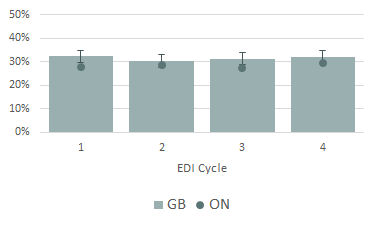School Readiness in Grey Bruce
The Early Development Instrument(EDI) measures school readiness across five domains:
- Physical Health and Well-being
- Social Competence
- Emotional Maturity
- Language and Cognitive Development, and
- Communication Skills and General Knowledge
Vulnerability in at Least One Domain
A low score on the Early Development Instrumentis considered an indictor of vulnerability. Nearly one third of children in Grey Bruce scored as vulnerable in at least one domain, presented in Figure 1 and Table 1 below. The rates have not changed much for either Grey Bruce or Ontario as a whole.
In cycles 1 and 3, Grey Bruce rates were statistically significantly higher than Ontario rates, but the difference in rates was not very large for either cycle, as Grey Bruce’s rate was only about 15% higher than Ontario’s rate.
Figure 1. Percentage of Low Scores in One or More EDI Domains, Grey Bruce and Ontario

Table 1. Percentage of Low Scores in One or More EDI Domains, Grey Bruce and Ontario
|
Cycle
|
GBHU Rate
|
Ontario Rate
|
|
1
|
32.3%
|
27.9%
|
|
2
|
30.2%
|
28.4%
|
|
3
|
31.1%
|
27.5%
|
|
4
|
32.0%
|
29.4%
|
Read the Full Report Here: Grey Bruce EDI Summary
Early Development Index
The Early Development Instrument(EDI) is a school readiness questionnaire that was developed, tested and validated by researchers at the Offord Centre for Child Studies at McMaster University. It consists of a checklist of over one hundred questions administered by kindergarten teachers that measures students’ readiness to enter Grade 1.
Scoring
Scores across the five domains are totaled and the proportion of children scoring in a low range for a domain is an indicator of well-being at school entry. A low score is considered an indictor of vulnerability.
EDI Collection in Ontario
EDI data have been collected in Ontario over four cycles, beginning in the 2003/4 school year. The cycles of data collection are as follows:
- Cycle 1 (2003/4, 2004/5 and 2005/6)
- Cycle 2 (2006/7, 2007/8 and 2008/9)
- Cycle 3 (2009/10, 2010/11, and 2011/12)
- Cycle 4 (2014/15)